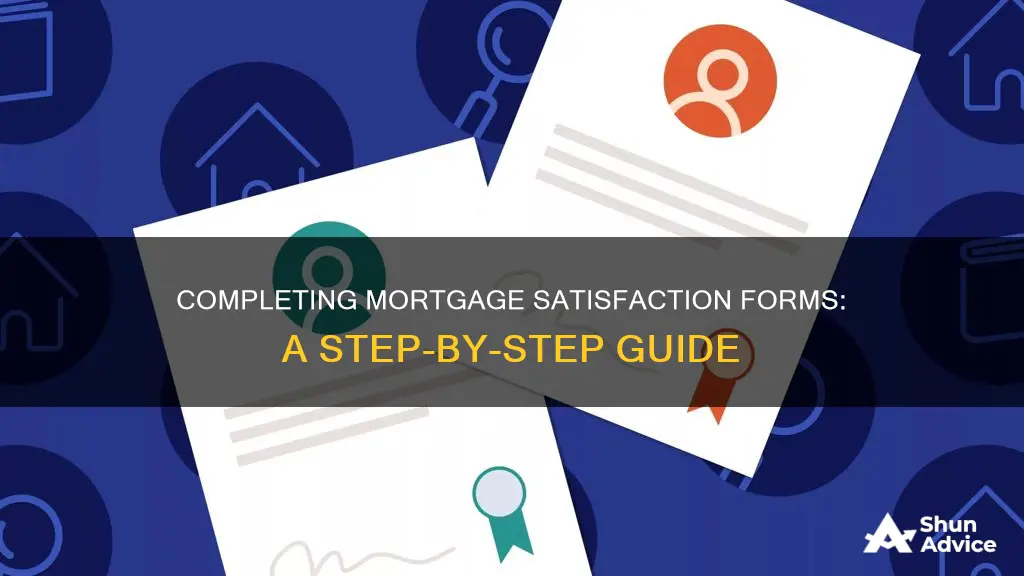
A satisfaction of mortgage form is a document confirming that a mortgage has been paid off in full. It is created by a lending institution and their legal counsel and must be signed by all parties to be valid. The form includes details of the mortgage loan, provisions releasing the lender from a lien against the property, and the steps taken to transfer the property title. It should be filed with the County Recorder or City Registrar, who will stamp the document with a filing number and any other necessary information. This article will explain how to fill out a satisfaction of mortgage form.
| Characteristics | Values |
|---|---|
| Purpose | Confirm that a mortgage has been repaid |
| Main parties | Mortgagor (borrower) and Mortgagee (lender) |
| Other parties | County Recorder, Land Registry Office, City Registrar or Recorder of Deeds |
| Information required | Mortgage information, recording details, legal description of the property, tax parcel number, amount paid, signatures of all parties, date signed |
| Time taken | Between 30 and 90 days |
What You'll Learn

Who fills out the form?
The satisfaction of mortgage form is filled out by the mortgagee, or the lender. This is the financial institution or entity that lent the money to the borrower (mortgagor) to purchase the home. The form is then signed by the mortgagee and all other appropriate parties, including the borrower. Some states will also require witnesses to be present.
The form is then filed with the County Recorder or City Registrar, or the Recorder of Deeds. This is done by the lender, who must record the release of the mortgage form in the county recorder's office in the county where the property is located. This step is crucial, as it acknowledges and documents that the mortgage has been paid in full and there is no longer a lien on the property.
The County Recorder will stamp the document with a filing number and any other necessary information to help identify and record it. This process ensures that the satisfaction of the mortgage is officially recognised and that the borrower has fulfilled their payment obligations.
In some cases, the original mortgage lender may sell the mortgage to another financial institution. In these instances, the owner of the mortgage at the time of the final payment is responsible for completing the satisfaction of mortgage documentation.
Understanding Mortgages in 1031 Exchanges: What You Need to Know
You may want to see also

What information is required?
The satisfaction of mortgage form is a document that confirms that a mortgage has been paid off and that the property is no longer a lien. It must be prepared, signed, and filed by the financial institution that owns the mortgage. The document should include the names of all parties associated with the mortgage, including the mortgagor (the borrower) and the mortgagee (the lender). It should also include basic information such as the details of the mortgage loan and its payments, the collateral property, and the steps taken to transfer the property title.
In addition, the satisfaction of mortgage form should include recording details such as the date the mortgage was recorded, the book number, and the page number. It is also important to provide a legal description of the property, including the tax parcel number. This number is necessary for assessing the value and identifying the ownership of a property for taxation purposes. It can be found on the Revaluation Notice, Personal Property Listing Form, or Tax Statement.
The satisfaction of mortgage form must be signed by all parties to be valid and may require witnesses in some states. Once signed, it should be notarized by a state-appointed official to authenticate the document. The form should then be filed with the County Recorder, Land Registry Office, City Registrar, or Recorder of Deeds, depending on the state. This step is important as it acknowledges that the mortgage has been paid in full and releases the lien on the property.
The process of preparing and filing the satisfaction of mortgage documents is typically handled by the lending institution, mortgage servicer, bank, or credit union. However, it is beneficial for the borrower to ensure that this obligation is fulfilled in a timely manner to avoid any issues with the lien release.
Capital Gains and Mortgage: What's the Connection?
You may want to see also

Where is the form sent?
Once the satisfaction mortgage form has been filled out and signed by all parties, it must be sent to the County Recorder's Office or Land Registry Office in the county where the property is located. This is typically done by the lender, although the borrower may need to do this themselves if they took out a mortgage with a private party. The document will be stamped with a filing number and other information to help identify and record it. This process is important to ensure that the lien is lifted and the title of the property is returned to the new landowner.
In most areas, the form will go to the County Recorder, Land Registry Office, City Registrar, or Recorder of Deeds. However, the specific requirements for filing the satisfaction mortgage form may vary depending on the state. For example, some states may require witnesses to be present when the document is signed, while others may use a Deed of Reconveyance instead of the Satisfaction of Mortgage. It is important to check the specific procedures mandated by the state in which the property is located.
The County Recorder or Recorder of Deeds will file the document and update the land registry to show that the mortgage has been paid in full and there is no longer a lien on the property. This process may take between 30 and 90 days to be completed, and it is important to ensure that the form is filed within the given time limit to avoid any potential damages set out by statute.
The borrower may also need to provide a tax parcel number or parcel identification number for the property, which can be found on the Revaluation Notice, Personal Property Listing Form, or Tax Statement. This number is used to assess the value and identify the ownership of the property for taxation purposes.
The Yield Curve: Mortgage Rates and Impact
You may want to see also

What happens if the form is not sent?
If the satisfaction mortgage form is not sent, the lien on the property will remain. This means that, despite repaying their mortgage in full, the borrower will not have a clear title to the property, and the lender will still have a claim to it.
In most areas, the form must be filed with the County Recorder, Land Registry Office, City Registrar, or Recorder of Deeds. The lender must file the form within a certain timeframe, which varies depending on the state or county. If the lender fails to file the form within the specified time, they may face penalties or fines.
The borrower may also experience adverse effects if the form is not sent. For example, they may need to take legal action to clear the lien on their property. This can be a costly and time-consuming process for the borrower.
Additionally, the borrower may wish to use their property as collateral for a business or personal loan. Without a clear title, this process may be more complicated or less advantageous.
Therefore, it is in the best interest of both the borrower and the lender to ensure that the satisfaction mortgage form is sent and filed promptly and correctly.
Adding Someone to Your Mortgage: A Simple Process?
You may want to see also

What is the document's purpose?
The purpose of a satisfaction of mortgage form is to confirm that a mortgage has been repaid in full. It is a document that is signed by the mortgagee (the lender) and acknowledges that the mortgage is recognised by all parties as having been paid in full and that the mortgage is no longer a lien on the house. It also details the provisions for the transfer of collateral title rights.
The document is created by a lending institution and their legal counsel. The original mortgage lender is often responsible for the mortgage throughout its life, but in some cases, the mortgage may have been sold to another financial institution. If this is the case, the owner of the mortgage at the time of the final payment is responsible for completing the satisfaction of mortgage documentation.
The satisfaction of mortgage form is important for the borrower as it provides proof that their mortgage loan has been paid. It is also useful if the owner wants to pledge the property as collateral for a business or personal loan.
The form will include the names of all parties associated with the mortgage, the details of the mortgage loan and its payments, an acknowledgement that all payments have been made in full, details of the mortgage loan's collateral property, and provisions releasing the lender from a lien against the property. It must be signed by all parties to be valid.
Pre-Qualification Mortgage: Effective Strategy for Home Buyers
You may want to see also
Frequently asked questions
A satisfaction of mortgage form, also known as a mortgage lien release, is a document confirming that a mortgage has been paid off. It also details the provisions for the transfer of collateral title rights.
The satisfaction of mortgage form must be signed by all parties involved in the loan to be valid. The two main parties are the mortgagor (the borrower) and the mortgagee (the lender). Some states will also require witnesses to be present.
The form must be submitted to the County Recorder, Land Registry Office, City Registrar or Recorder of Deeds. The document will then be stamped, and a clear title will be returned to the new landowner.







